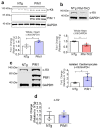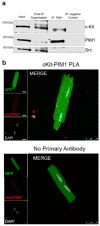PIM1 Promotes Survival of Cardiomyocytes by Upregulating c-Kit Protein Expression
- PMID: 32878131
- PMCID: PMC7563506
- DOI: 10.3390/cells9092001
PIM1 Promotes Survival of Cardiomyocytes by Upregulating c-Kit Protein Expression
Abstract
Enhancing cardiomyocyte survival is crucial to blunt deterioration of myocardial structure and function following pathological damage. PIM1 (Proviral Insertion site in Murine leukemia virus (PIM) kinase 1) is a cardioprotective serine threonine kinase that promotes cardiomyocyte survival and antagonizes senescence through multiple concurrent molecular signaling cascades. In hematopoietic stem cells, PIM1 interacts with the receptor tyrosine kinase c-Kit upstream of the ERK (Extracellular signal-Regulated Kinase) and Akt signaling pathways involved in cell proliferation and survival. The relationship between PIM1 and c-Kit activity has not been explored in the myocardial context. This study delineates the interaction between PIM1 and c-Kit leading to enhanced protection of cardiomyocytes from stress. Elevated c-Kit expression is induced in isolated cardiomyocytes from mice with cardiac-specific overexpression of PIM1. Co-immunoprecipitation and proximity ligation assay reveal protein-protein interaction between PIM1 and c-Kit. Following treatment with Stem Cell Factor, PIM1-overexpressing cardiomyocytes display elevated ERK activity consistent with c-Kit receptor activation. Functionally, elevated c-Kit expression confers enhanced protection against oxidative stress in vitro. This study identifies the mechanistic relationship between PIM1 and c-Kit in cardiomyocytes, demonstrating another facet of cardioprotection regulated by PIM1 kinase.
Keywords: PIM1; c-Kit; cardiomyocyte; cardioprotection.
Conflict of interest statement
The authors declare no conflict of interest.
Figures





References
-
- Zebrowski D.C., Vergarajauregui S., Wu C.C., Piatkowski T., Becker R., Leone M., Hirth S., Ricciardi F., Falk N., Giessl A., et al. Developmental alterations in centrosome integrity contribute to the post-mitotic state of mammalian cardiomyocytes. Elife. 2015;4:e05563. doi: 10.7554/eLife.05563. - DOI - PMC - PubMed
Publication types
MeSH terms
Substances
Grants and funding
LinkOut - more resources
Full Text Sources
Molecular Biology Databases
Miscellaneous

